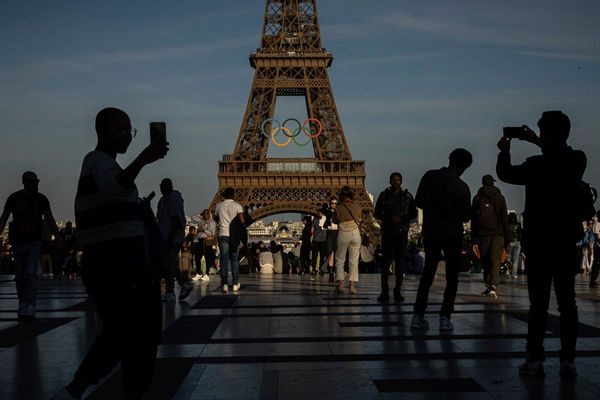
A forest of curious cement statues stands on the edge of the city of Chandigarh in northern India, their bodies dressed in colourful costumes made from beads and broken glass bangles. There are figures of women carrying baskets on their heads, alongside dancers and athletes, police officers and patients, ministers and musicians, beggars and children – scenes of rural village life, frozen in mineral form. An army of concrete monkeys squat on a slope nearby, while a herd of oxen roam a tiled pasture, their bodies covered with fragments of broken china. Narrow passages weave between these mystical tableaux of ceramic creatures, channelling visitors through deep gorges, past streams and waterfalls that cascade between the lush vegetation.
This sprawling 25-acre fantasy land is the arresting vision of Nek Chand Saini, a local highways inspector turned self-taught sculptor, who spent years piecing together his dreamscape in secret. While the Swiss architect Le Corbusier was building his megalomaniacal plan for the Punjab capital – a place of imposing government buildings linked by monumental axes – Chand was busy collecting leftover construction waste, and fashioning it into a spiritual mirror image of the modernist city. “What Le Corbusier built is the sky,” Chand said. “My work is the earth.”
Some fragments of his earthy/unearthly Rock Garden have now made it to London, currently on show at the Gallery of Everything, a space dedicated to the work of self-taught artists and makers beyond the cultural mainstream. One of Chand’s bearded Indian sadhu figures sits in the gallery window in Marylebone, looking out with gnomic judgment at punters tottering out of the swanky Chiltern Firehouse hotel across the street. He is flanked by two smaller spiritual beings, sitting cross-legged, adorned with beads made of broken ceramics and hairstyles made from chips of asphalt and clinker gathered from the roadside. Further scenes await inside: a trio of dancers, a police officer, a green tiled horse and dog either side of a bangle-spangled figure, a totem pole of heads – all conjured by this imaginative outsider.
“Calling him an outsider artist is diminishing his capabilities,” says the gallery’s founder, James Brett, who first visited the garden in Chandigarh over a decade ago, and met with Chand a number of times before his death in 2015. “He was a sculptor, architect, urbanist and land artist, who devoted his life to capturing the essence of everyday India.”
Chand began his secret project in 1958, the same year that Le Corbusier’s Secretariat building was completed. While that brutalist concrete pile was a monumental hymn to the right angle, Chand’s “Kingdom of Gods and Goddesses” would be a place of curves and organic forms, guided by higher powers. It was also an evocation of a lost childhood. Born in 1924 near Lahore, in what is now Pakistan, Chand and his family had to flee to the Indian side of the border in 1947, following the botched partition of the former British India. Expelled from his home, the garden would be his chance to realise scenes from the stories his mother had told him of a beautiful lost realm.
Chand knew the plan for Chandigarh well, from his work supervising the construction of its roads, and he identified a swath of overgrown land to the north of the city, where there were no plans to build. He fenced it off with a cordon of rusty barrels and a big branch, and got to work, spending at least four hours each evening fashioning his clandestine fantasy. For the first six months he even kept the project secret from his wife. As he later remarked: “Nobody had an inkling of what was going on in the bushes.”
He would cycle for miles, looking out for striking stones, and gathering detritus from building sites, restaurants, hotels, electrical stores and medical suppliers. “What they threw away,” he said, “I used.” It became an obsession, to which he devoted every minute of his free time. As a guide to the garden puts it: “On every holiday, he ignored domestic liabilities and instead of spending time with family, he used to bicycle to riverbeds, mountains, jungles in search of his ‘treasure’.”
Chand deployed bits of broken bikes to make the armatures of his sculptures, using their frames, seats, mudguards and handlebars to form basic skeletons, which he then daubed with mortar. Each figure was smoothed over with a layer of cement, and decorated with broken crockery, rusty coins, old bottle caps and dud lightbulbs, deities clothed with costumes of upcycled junk. It was a vision of everyday India made from everyday bits and bobs. But it had an important devotional aspect, too. “It all came from my heart and my imagination,” said Chand, who included symbols of the Buddhist om, the Hindu swastika, and the Christian cross embedded in the ground. “This garden is more than an offering to God. It is a gift from God.”
A film in the exhibition, projected in an atmospheric vaulted brick room downstairs, takes you on a journey through the narrow passageways and low arched doorways that connect the different areas of the garden. We see walls encrusted with thousands of old plug sockets, creating a bristling, coral-like surface. We find a row of swings dangling from a colonnade of arches, between chubby elephantine columns. These fat pillars were made using another of Chand’s innovations, casting concrete against piles of jute sacks filled with mortar, leaving a squidgy imprint – a soft foil to Le Corbusier’s sharply hewn concrete walls. It is a monumental achievement. Could this all have been the work of just one man?
Well, not exactly. In 1973, with an eye on urban expansion, the local government decided to clear an area of thick undergrowth north of Chandigarh’s Capitol building – and uncovered Chand’s secret world. The authorities’ views were divided over what to do with it. But, with an eye on the tourism potential of this weird wonderland – and with the support of Chandigarh’s first Indian chief architect and heritage advocate, Manmohan Nath Sharma – the government allowed it to remain. Not only that, they decided to give Chand a helping hand. At the age of 52, he was relieved from his duties as a highways inspector, appointed “creator-director” of what was now branded the Rock Garden of Chandigarh, and given a team of 30 workmen to help complete his vision.
What had been a relatively small endeavour suddenly took on the scale of a civil engineering project. Chand and his team developed a sophisticated system of watercourses, designed to channel rainwater during the monsoon season and pump it into a great vat, where it was filtered, purified, and sent 20 metres up a slope to then cascade down a series of waterfalls. He established a dedicated plant nursery, where he cultivated mango trees, bougainvillaea, cacti and papyrus. Earth was moved, ravines excavated, and cliff-sized walls raised. It became a far more popular attraction than the famous modernist city that had spawned it, receiving more than 5,000 visitors a day. According to the local tourist board, it is the one of the most visited sites in India, second only to the Taj Mahal.
But its safety wasn’t always guaranteed. In 1988, the high court applied for permission to remove part of the garden to make way for a new “botanic park”, arguing that it violated the city masterplan. That attempt was foiled. The following year the government proposed to plough a new road through the garden to connect to a nearby village – a plan that was only halted by 1,000 people turning up to form a human shield. Mixed fortunes continued. In 1996, while Chand was on a tour of the US, the garden suffered a wave of organised vandalism. Funding was withdrawn, prompting international fans to establish the Nek Chand Foundation, organising a network of volunteers to help with upkeep. But ongoing maintenance remains an uphill struggle.
This December marks the centenary of Chand’s birth, and plans are under way for a fitting celebration of this unique character, who has been immortalised as a waxwork figure in a shrine in his garden. Not that he would have wanted a big party. There is a moment in the film, shot in 2013, when Chand is asked what he thinks of his reputation, and the international recognition the garden has received. Does he now see himself as a celebrated artist? “I never thought anything about it,” he replies. “I just go on working, working, working.”







